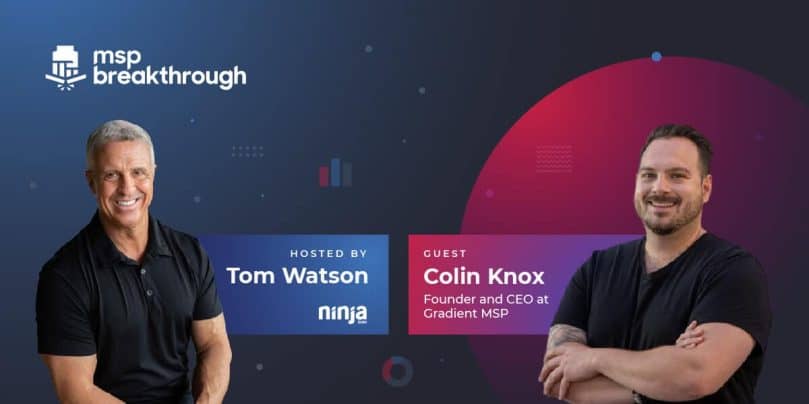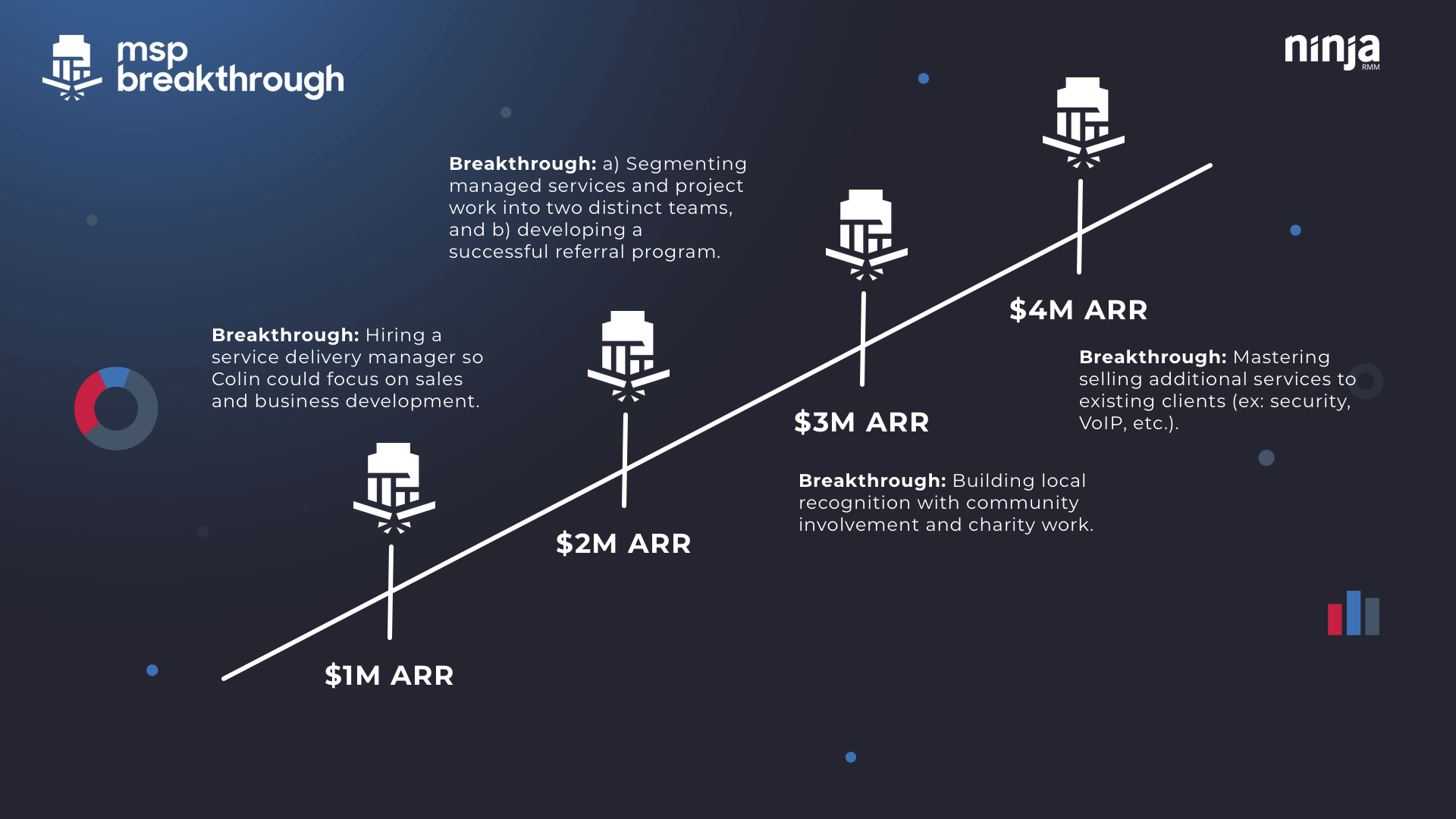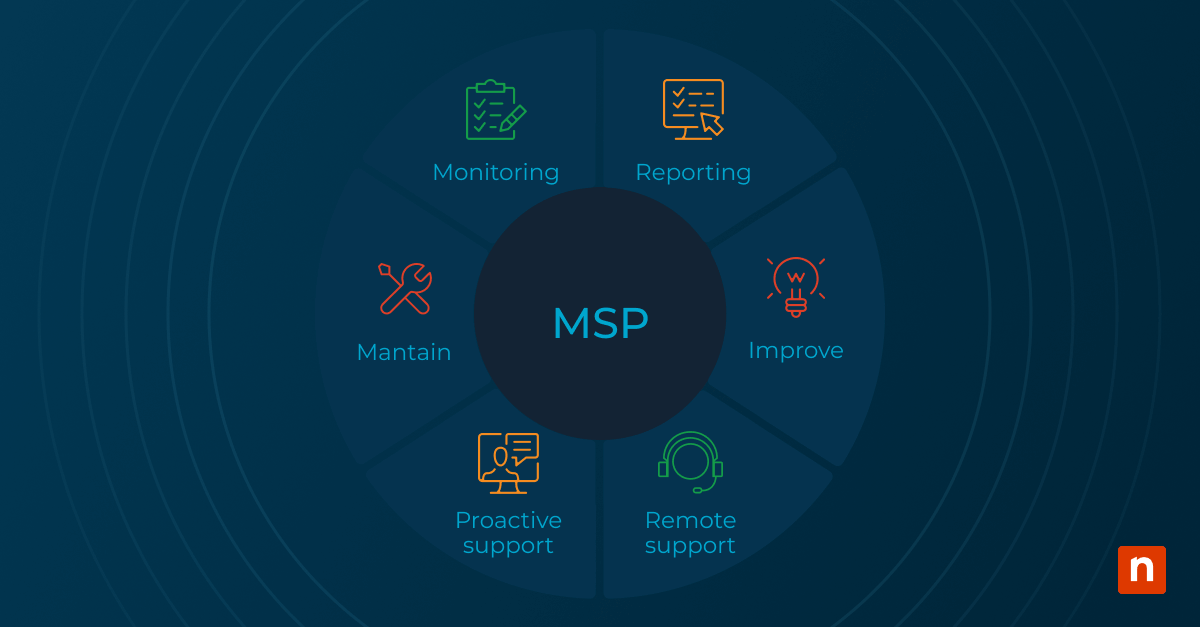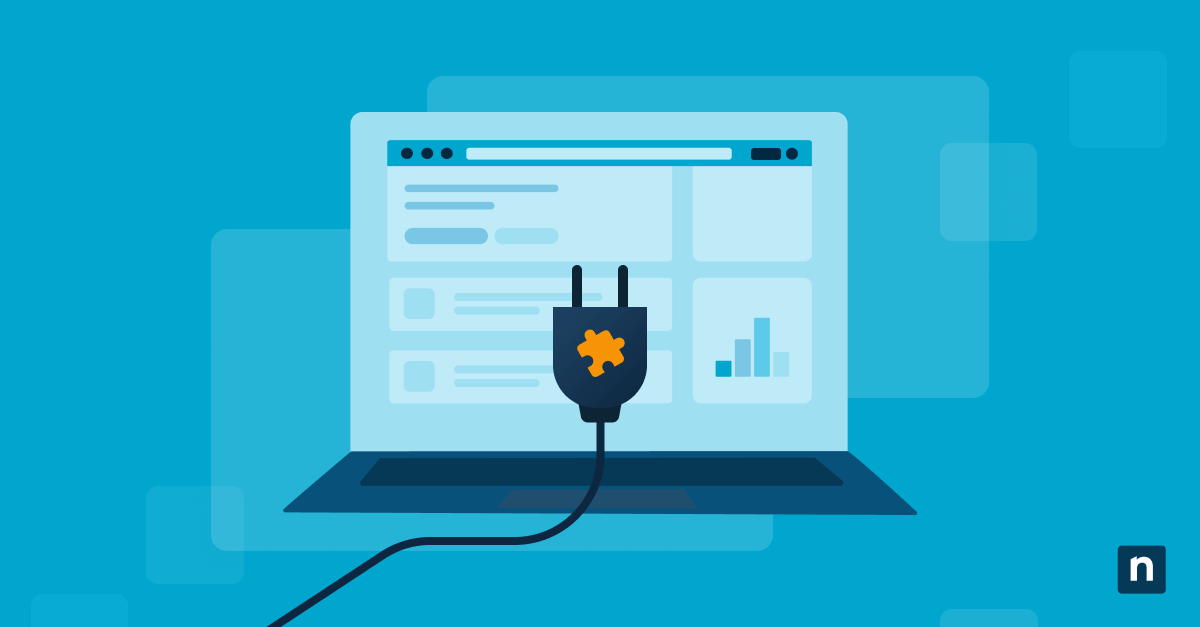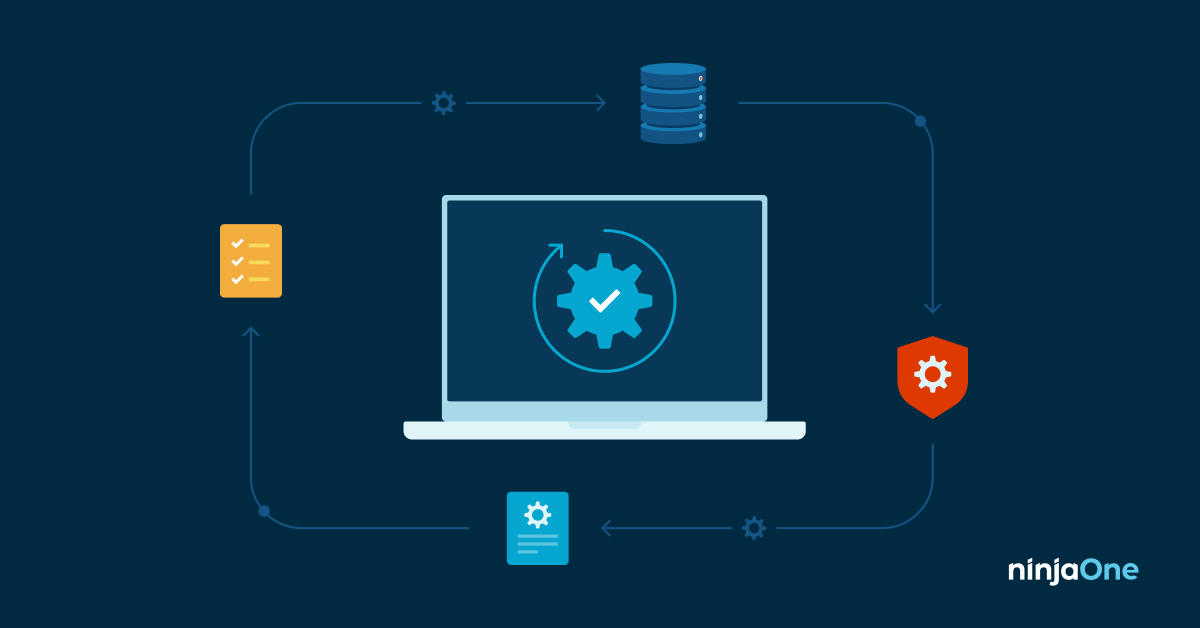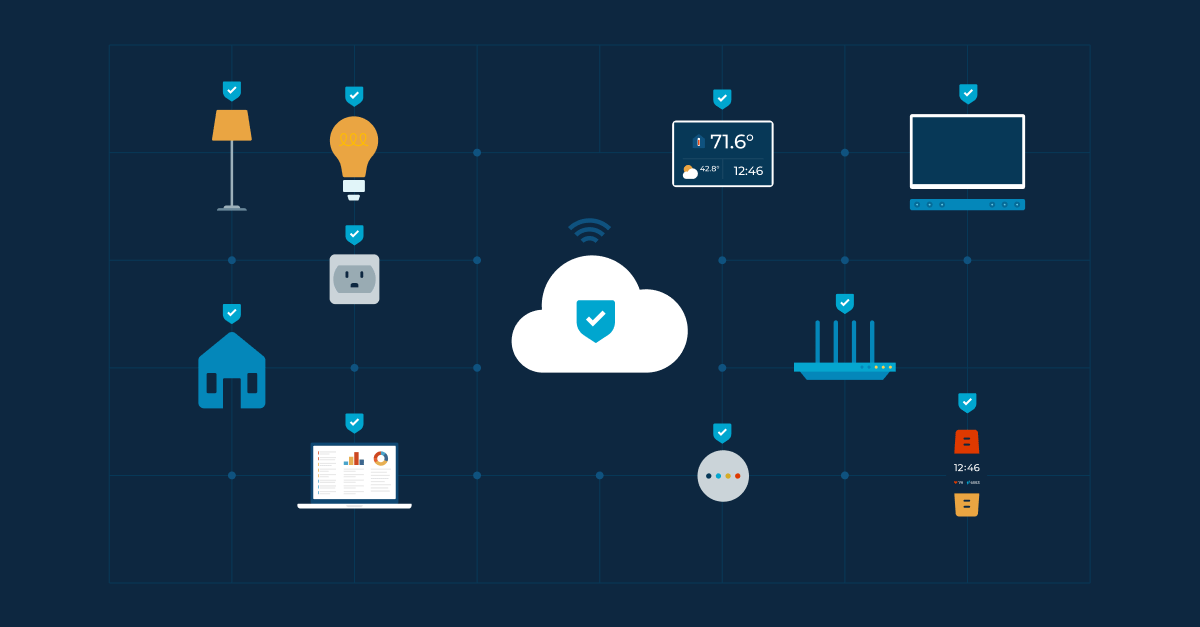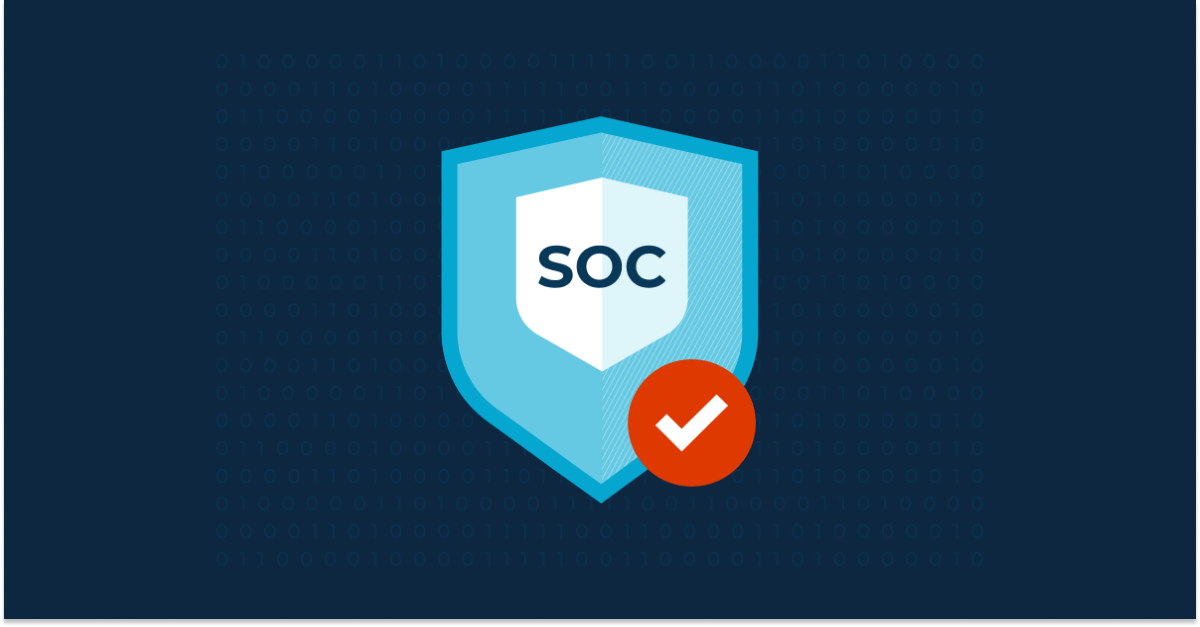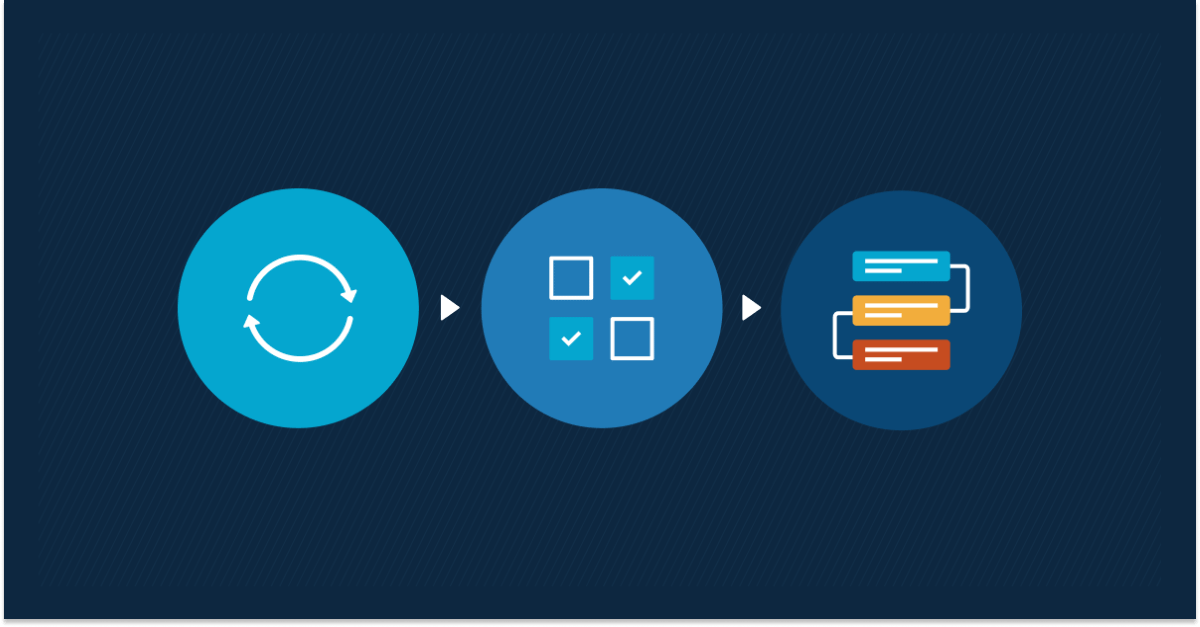Tom talks with former MSP owner, Passportal founder, and now Gradient MSP CEO Colin Knox, and learns what it took for Colin to delegate the technical work, embrace automation, and achieve exponential growth with the help of loyal advocates.
Colin Knox has worn many hats in the channel. As founder and CEO of Passportal, he built a solution tailor-made for MSPs that saw massive adoption. When Passportal was acquired by SolarWinds in early 2019, he stayed on and became head of community at the company, further broadening his first-hand grasp of the unique challenges and pain points that MSPs face.
Now he’s launching a new endeavor aimed at giving MSPs another powerful tool. Called Gradient MSP, it’s currently in Beta and stirring a lot of curiosity. The (highly anticipated) launch is scheduled for June 1.
But before all that, Colin was an MSP owner. In less than seven years, he grew XCEL Professional Services into a business generating millions of dollars in ARR, and in 2016, he sold the business to F12.
In the first episode of our new MSP Breakthrough series, Colin sits down with NinjaOne Channel Chief Advisor and fellow former MSP owner Tom Watson to discuss hurdles and lessons learned, including:
- The challenges — and opportunities — of economic uncertainty
- Breaking past $1M, $2M, $3M, and $4M in ARR
- Communication > service
- Hiring is the #1 accelerator
- Simply being responsive will put you ahead
- Not an extrovert? Let your website and advocates sell for you
Listen
Like the show? Please consider supporting it with a 5-star review. We’re just getting this sucker off the ground and that will help a lot!
You can review/subscribe at either of the following:
Watch
Read (transcript)
Announcer: This is “MSP Breakthrough,” where successful MSP owners walk us through the pivotal moments that put them over the top.
Jonathan: Hey, everyone. This is “MSP Breakthrough.” I’m Jonathan Crowe, Director of Content and Community at NinjaOne. I’ve got with me Tom Watson, our Channel Chief Advisor. And for this episode, Tom, I understand that you’ve got a big name that a lot of people that have been in the channel for a while are going to definitely recognize.
Tom: Yes. I spoke to Colin Knox. And Colin has a really interesting background. He was an MSP owner and sold that MSP, and then he built Passportal, which many of you have probably heard of and might even use.
Jonathan: And, of course, Passportal was acquired by SolarWinds. And now, Colin is doing a new venture, Gradient MSP. So, I understand you guys are going to be talking about that and some breakthroughs that he had through that long career. I’m sure it’s an interesting talk. Can’t wait to hear it.
The challenges — and opportunities — of economic uncertainty
Tom: You mentioned you were starting your MSP at the time when I’m completely transforming my MSP into more of a full…because you know that period of time, 2008 to 2010 is when IT providers started becoming more true managed service providers and contracting everything up. I was right at kind of the front end of that movement. And yeah, a lot of people were like, “Why would you want to mess with the clients and the relationships right now?” And I was like, “I have to constantly be evolving this business.” But something else that goes on during these tough times, when movement and change happens during tough times, you tend to become better at it than in the really flush times, because you’ve got to be more efficient. You’ve got to be smarter.
And then what happens is, when times get really good, you have perfected your way of doing business in tough times. You just flourish. And I think the big message I would send to our audience there is, this is a perfect example. Many economies are affected by the pandemic, but this is the time to execute and to be growing their business. If you do it now, wow, you can really rock later on. Am I right?
Colin: There’s no motivator like desperation. I’m being candid. Right? I mean, it’s one of those things for an MSP in an economic crisis or whatever you’re dealing with. You need certainty in the future of your business. And the only way to do that, you have this managed service offering you have where you know how much money is going to come in. You know what you’re going to get paid. On the flip side of that, your clients need cost certainty. They need to know what it’s going to cost them so that they don’t have blips and peaks and values all over the place.
“There’s no motivator like desperation. I’m being candid. Right?”
So, it made a lot of sense when we were going out in the middle of a recession, and offering people these flat-rate contracts because it’s something that they could understand. It’s something they could budget and plan for, and drive it forward. So, yeah. I’m a big fan of being all in on things. Whether you’re investing in a new business and doing that, whether you’re dealing with a crisis, you know, having that little bit of desperation, that little butterfly in your stomach about how much at risk am I here right now is a great motivator.
Breaking past $1M, $2M, $3M, and $4M in ARR
Tom: You accelerated very fast and scaled this business up, this MSP in six years and sold it. But along the way, I’m sure there were still some bumps and some hurdles. Do you remember any in particular, maybe a breakthrough to get past it?
Colin: Yeah. I think there was a few. You know, hitting our one million or our first million went really quick for us. And that was just pounding the pavement and leveraging the hell out of my network. But as we were looking at breaking past that and what we were going to need to do to hit the next million and beyond, early in that first million, I already had to make the decision that I was going to hire people to do the service work, and kind of pull myself out of that, remove myself from that so I could focus on business development, I could do sales, and I could grow that business. And that was a sacrifice that I had to make.
I could have paid myself that high six-figure salary, could have been very cushy and good, you know. But for a one- to two-year period, you take that down, you’re not necessarily committing to $60,000 or $70,000 no matter what when you hire a technician. You’re committing to a monthly payment towards that. And if they don’t work out, it sounds rude, but kick them out and get somebody else in that’s going to work. So, that was one of the big things that was having to remove myself.
And then the next is when we had two to three technicians and I found I was spending just as much time trying to manage those people and lead and coach those people as I was trying to do business development and sales to grow the business. That’s when I had to have and put somebody in charge of the technicians or the service delivery team. So that that person could manage that. I could have a regular meeting with that person and then stay focused on sales and business development. So, that’s what helped us get into that next bridge into the two million range.
“The well was dry. My network was empty. And the people who were going to buy from me that knew me were already buying from me. So, at that point, I had to figure out the referral campaign.”
When I think back to the…you know, what we did to go from two up to three and beyond, you know, one of the key things was I had expanded…like, the well was dry. My network was empty. Right? And the people who were going to buy from me that knew me were already buying from me. So, at that point, I had to figure out the referral campaign. And I had to not just do some simple, easy thing, but we had to really master a campaign that motivated the individuals, the clients that we had, and motivated the people that we were looking to bring on.
So, you know, figuring that out when it came to a market development standpoint was important. And then realizing that we needed to create a segregation because the two sides of any IT service business is you’re always going to have projects to an extent. Then you have your managed services. But how many times has your technician been on site trying to configure something in the virtual system or connect something or build…you know, implement a new firewall, whatever it is, and then somebody’s tapping on their shoulder saying, “Hey. While you’re here, can you fix my Microsoft Word? I’ve got this error.” And then the projects would go over budget or the service or whatever else.
So, when we were able to separate those teams of people, the projects people were able to say, “Hey, I’m actually here only focused on this. I’m not part of the managed services team. But if you call the help desk, somebody will pick up right away, help you remotely, and take care of that for you.” So, that was a big part of separating it.
And then, you know, as we kind of looked to scale into the next level, it was a lot of figuring out, 1) getting somebody to help with sales, but 2) figuring out how we could get access to other opportunities and prospective clients without paying the big bucks to get radio ads, TV spots, billboards, all of that stuff.
So, I had read a book and saw how somebody leveraged community involvement and charity work to build their business. And you can’t do it with the sole purpose of doing charitable things and events and everything else. To make revenue, you have to have a sentiment of altruism to it, but we double down on community involvement. We donated to charities, we sponsor charity events, we participated in them. We, you know, went and made food for the hungry. We made lunches for kids that went to school without lunches. We did all of these things, you know, started working with schools and talking at schools to help foster younger people into tech. And ultimately, that started driving more interest and more access to the market because they saw on our social media that we were out doing charitable things. The charity started to come on as clients. And that really helped us go forward.
As we got to a certain level and a certain stage, when we were at that four million and looking at what do we need to do to pull past and hit… I mean, it’s fairly well-known today that an existing client — I think it’s 30% — is 30% more likely to buy something from you, maybe even more than somebody who doesn’t buy anything from you. And it’s seven times cheaper to keep an existing customer than it is to get a new one. And so, we had to learn to master the skill of mining our clients for additional revenue, whether that was putting together a managed security bundle that we created back then and started offering that, whether that was getting into, you know, VoIP services at the time and offering that.
There was a way that we had to go to clients and not feel like we were nickeling and diming every time we came to them, we were asking them to buy something new. But finding something that would deliver a good business outcome for them, and then proposing that in their best interest. So, those are some of the skills that we had to kind of fine-tune and master and put into place in order to help us break through various revenue levels.
Communication > service
Tom: Colin, in particular, we’re talking about here the first part, is stepping away. And I think the audience would find great interest in this. And there’s two things that happening here. I remember myself, I hired a part-time technician to help me out very early on. And I think that’s very important. But the one main one you spoke of that’s so important is when you step away from doing the technical work. And it’s difficult because you have other people in your company that expect you to be the lead technician, to carry the torch, to have the most information, to make the final call and all of that. And then, of course, you have the clients who have this relationship with you. They saw you fix their machines, they expect you to come out there. And there’s a lot of things pulling on you.
And I remember having to step away from that and say no to a lot of people. And I remember as well the quality of service for a period of time dropping while I… But then I enabled those people, and they got stronger. Do you remember that as well?
Colin: Yeah. You know, I think nobody ever puts the same level of effort into delivering a service or product that the founder or the owner will. Right? They’re always going to be, as a result, the best salesperson, always going to be the best service person because they have a lot more on the line. So, I think we did have some quality of service issues that happened on the outset. But I think it came to finding mentorship opportunities and learning opportunities where we could coach those people, and then give a little bit more emphasis on the communication with the clients. Right? If you’re focused on the customer experience a lot more, they’re going to give a benefit of the doubt, because it’s the overall experience in dealing with your business.
“Very seldom is it, ‘How fast do they solve my issues?’ It’s, ‘How amazing was…the person helping me?’ It’s all about communication.”
It’s not just, you know, Jane or John that’s in there doing the work. It’s how they feel about your company. Everything from when they put in a request, what’s that experience like? When they’re talking to your people, what’s the experience like? Very seldom is it, how fast do they solve my issues? How amazing was whatever about the person helping me? Right? It’s all about communication. We had issues where there was six, seven hours during a business day that either somebody couldn’t work or part of a company or the whole company couldn’t work because tech fails.
And we could have been judged and lost those clients, but we just kept…and I always emphasize this with our staff. Just keep the customer in the loop at all times. Let them know what you’re doing. Let them know what you’re anticipating. Let them know how it’s going. Because when there’s that void of the customer not knowing what’s going on, you think nothing is being done, and then you get frustrated. I mean, we do it today. If I’m sitting here trying to export a video this morning and it just…I don’t even have a processing gif or I don’t have a bar that’s showing me how it’s progressing. I don’t think anything is happening. So, I get ticked off, I close the browser, I try this.
It’s the same thing with IT services. If they don’t know what your plan of attack is, if they don’t know what you’ve tried already, they don’t see that you’re constantly getting back to them maybe every hour, every 45 minutes to say, “Hey. We haven’t forgotten. We’re still working on this,” that’s going to change everything in it.
So, we really coached on communication. We kept a close touch with our customers. And, yeah, some of the quality of service failed, but I think the confidence and the growth of our team also improved because they saw that we believed in them. They saw that we were backing them. And they were taking on the coaching we were providing instead of reprimanding for issues, and help level them up to get that level of service to where it needed to be.
Hiring is the #1 accelerator
Tom: I think the big takeaway here is, if you really want to scale your business up, you’re going to have to step away from technical work. You have to enable your team. But I think the big question, I’m sure, from many people tuning in here is, when do you know the right time to do that?
Colin: So, I think if you want to grow a business, like, there’s nothing wrong with being a one-person shop or a two-person shop. There’s nothing wrong with it. You can have a very healthy business, you can have a good living off of it.
If your goal is to build a business to ultimately increase the value of that business and the value that’s going to hit your pocket and ultimately maybe someday be acquired and have that liquidity event, you need to do that as early as possible. Now, I’m not saying you should go take a bank loan or remortgage your house to make this happen. But if you’re at a point where you’re making and bringing in even $10,000 a month in revenue, I mean, your costs on that revenue for your services is fairly low unless a lot of that is resale and it’s your underlying backup solution and everything else. But between your RMM and your PSA, you shouldn’t be paying a huge percentage of what your revenue is at that point.
Would it absolutely kill you to drop your salary in half to $4,000 or $5,000 a month, instead, and put that other half in another technician, get them working, get them up to speed, and then you can…you know, you keep…maybe for the next period of time, you keep your four to five grand a month again. And you might have to talk to your spouse if you’ve got a partner or whatever else to get coverage on it. But then hire another technician. And eventually, maybe it only takes one or two years. You get back up to your $10K, your six-figure plus salary, and then it’s just a matter of managing capacity and sales. Right?
“[Hiring is] the best investment you’re going to make. It’s going to be better than investing in marketing. Better than finding the next best thing to resell. It’s all about getting the people in capacity so you can remove yourself and start to exponentially scale that business.”
So, for me, I mean, I started up my MSP in August. By October, we hired a person. By November, we hired another person so that I could completely remove myself. And we had that first person. I made sure that they understood how we do business, how we deliver our services, how we work with our clients. And then they were able to kind of coach and mentor and get the other person up to snuff so that I could be back and focus on selling and building the business that way. So, I’d say, do it as early as possible.
If you’ve been running for 5, 10, 15 years and you’re still a one-person shop or two-person shop, look at the revenue you have, look at your cost, and see what your bare minimum is for your own income, and invest the rest in another person. That’s the best investment you’re going to make. It’s going to be better than investing in marketing. It’s going to be better than finding the next best thing to resell. It’s all about getting the people in capacity so that you can remove yourself, and just start to exponentially scale that business.
Tom: I agree with that. Yeah. As soon as you can hire someone to take the load off of you, you should do it. And I think the message…the takeaway on when do you step away from tech, I can tell you myself, it was at the point where I was losing out on deals, potential new business, because I wasn’t following up on it fast enough. And so, when you get to that point that you know that there’s deals that you’re not getting back to someone quickly enough, you’re not updating the CRM, you’re not getting the right touches in, well, that’s the time you need to become more business development person and a leader of your organization and less of a worker in it. And that’s the time to step away and you start to draw a line in the sand.
I had to draw a line in the sand with many employees and many clients. And I had to say, you know, “I just can’t do this. I don’t have the time. I can’t give you the best service if I’m doing these other things.” By me running it from this level, I can communicate with you all on a business level, but the technical level has to be these other people. And you’ll also build a stronger company because you will enable those people below you to take over those duties and have a level of leadership on the technical side.
Simply being responsive will put you ahead
Colin: Yeah. And I mean, you look at it, you said a good thing, right, is you were losing opportunities. So many MSPs don’t answer the phone. They don’t respond to inquiries because they’re too busy doing the business that they’re selling. They’re too busy putting out fires and managing client networks and IT systems, which is crazy. At Passportal, when we went to, you know, do a search for an MSP to outsource our IT because we hit that level where it’s, like, “Okay, Colin is spending way too much time managing our own IT. We need to hire a company to do it.” We reached out to 10 companies. Three of them responded to us. And of the three, only one got us a proposal within a week. That’s because they’re all too busy, and maybe some of them just didn’t care much. Who knows?
But, you know, that’s the craziness of it. You’re missing opportunities. And a lot of people say, “Hey. I went and I tried the marketing thing or whatever. It didn’t work. My business didn’t grow.” If you’re not monitoring your emails, if you’re not picking up the phone when people are calling you, people don’t leave voicemails today. That’s not the norm anymore.
Tom: They call the next one on the list. That’s what they do.
Colin: Exactly. You didn’t answer the phone. I’m on to the next. Or if I email you, if I don’t hear back from somebody on a sales email within two hours during the day, I’m on to the next. I’m buying someone else because the iron’s hot and I’m looking to do things.
“It’s all about making yourself available. And you can’t make yourself available if you’re still doing all the tech work.”
You can’t drum up interest and then not respond to it because, guess what? The customer experience, even though they’re not a customer yet, just went down the drain. Because if that’s how you are when I’m trying to buy from you, everybody’s got this perception that when I’m buying something, that’s the best experience I’m ever going to have and best relationship I’m ever going to have with them. Second I buy that’s going to go downhill is the expectation.
You buy a house. The second you give them the money, oh, now, they’re not responding to me to come fix this and that. So, if during the sales process or even the interest level, you’re not getting back to people, you’re not responding to them, imagine what their perception is of what it’s like to do business with you. So, it’s so keenly important for you to be separated out so that you can respond to people. I mean, we had times where I responded to an inquiry on a Saturday afternoon because something came out.
I was out walking the dog, saw an email, just responded back. We closed the deal that day because they were having an issue and they needed to do stuff. Yeah, there’s something to be said about a work-life balance. That literally took 15 minutes out of my day on a Saturday, emailing while I was walking. Had maybe a 10-minute phone call and closed the deal. And then told them we’ll be in there Monday. So, it’s all about making yourself available. And you can’t make yourself available if you’re still doing all the tech work.
Tom: That’s right. I hear a lot of people talking about, you know, getting new business. I figured out very early on. I had a local phone number and the prefix was the oldest in the area, which was well-respected because it looked…because people knew. And I had to fight to get one of those because people knew that that prefix was for generally well-established businesses that have been around a lot longer. And then I had a human being directly answer the phone by the second ring between 8 a.m. and 6 p.m. Monday through Friday. And I will tell you what. I got so much business just by that because then I would also get referrals because of that. People would be like, “These guys answer the phone.” Not even an auto attendant in the way. Straight up person answer the phone and I’ll tell you what. That one move paid for that person answering that phone hundreds of times over. And it was so simple.
And I call all the time. You know, I’m not going to call anyone out here, but I communicate with a lot of MSPs. I work in the industry. I spend a lot of time on people’s auto attendant systems, and giving options, and not getting through to people or it’s ringing other phones and all of these things. I got to say, like, what if you paid a human being? Or maybe it’s a service. I had my office manager answer the phone because I wanted someone who could begin the sales process right then. And then when I got a dispatcher, I had the dispatcher answer the phone, and I had a dispatcher I hired away from the sheriff’s department 911 team. So, they had this ability to talk with urgency with people.
It sounds like we’re on the same page with this. If you want to get a lot of business out there, make yourself available, as you said. Answer the phone. I had a thing. If I saw the email and it was business development related, I always try to send some sort of response within 60 seconds of getting it. And that got me a lot of business as well. Simple things.
Colin: Yeah. Like, when we were one, two, three people, I did an answering service. It was a 24/7 answering service. And it was very simple to do. And somebody always answered the phone. Didn’t matter if it was 2pm or 2am. Somebody answered the phone. And they had our cell numbers and they could transfer a call. They could take a message. They could do whatever. And it was so simple to do. And maybe with the amount of calls we were getting, that cost us maybe up to $100 a month, on a crazy month. Yet it made all of the difference.
Again, somebody answered the phone. They were pleasant, they were cheerful, they took a message or they transferred it to a cellphone. And if I was stuck at a client and I was doing something, you can excuse yourself for two minutes because chances are you’re not face-to-face talking with that customer. You’re working on a computer, you’re in the server closet or network closet doing something there. You can leave. Like, if you had to take a break to the restroom, you can leave to…you can take two minutes to accept a phone call and talk to somebody and just hear them out. And then get back to them again after. It’s just simple things that you can do that make all of the difference.
Not an extrovert? Leverage your website and advocates sell for you
Tom: Now, Colin, I think one last thing on that. The people tuning in, they just don’t like to be on the phone. It sounds like you and I, we’re pretty natural on the sales idea. I love to talk to people. Obviously, I work and create content like this now. I like to be out there in front and talking, presenting, closing deals. But there’s people that don’t and we respect that. But that’s fine. If you don’t, then one of those early hires probably needs to be someone in business development, someone who can be that focal point and talk to people and combine that with services the way you answer the phone. Even if you’re not that person, identify you have that need in your business and bring the right people in to do the pieces that you either don’t want to do or aren’t good at.
It sounds like both of us were good at identifying what we wanted to do in the business and then what we were unwilling to do or didn’t want to do.
Colin: Yeah. I think, you know, back when we were running our businesses…not making us sound old, saying back then, but it was more common for people to phone. You look at even over the last 5 to 10 years, how the average consumer and that buying journey has transformed, you know, two-thirds of people today don’t want to talk to a sales rep to buy something. They do their research online. They reach out, they look for email. How many email inquiries do you get now that say, “Do not call me. Keep it to email.” They don’t want to talk to people over the phone. They don’t want to be pressured. So, for those of you that don’t like talking on the phone, that don’t like trying to sell people, you can automate so many of that. Put up a good storefront on your website online. Look good. Look the part, because that’s the other thing here.
You know, yeah, we probably spent $5,000 or $6,000 back then on having a beautiful website designed. Hiring a graphic designer to do a nice logo for us, making sure that we looked the part so when people went on the website, they felt a level of confidence of quality. So, they were able to reach out and get a hold of us. From there, you can automate it. You can have automated responses that go back and say, “Hey. Here’s how we do it.”
There’s chatbots now. Like, I never had the opportunity for chatbots back then. When you could start engaging with somebody on the website the second they were there, and then program journey using questions and answers, give them your pricing. Guess what. Your pricing is your pricing. If there’s variability in what you charge a client based on who they are, where they are or whatever outside of how many people or how large their business is, I’m sorry, but you don’t know exactly what you’re doing. And that doesn’t give confidence that, you know, they’re going to be charged a fair rate.
We were straight. It was X amount per user per month. I think we were 120 or 130 per user per month. That’s what we did. Somebody asked for a pricing. Boom, there was our pricing. Because if that’s in your budget, we want to talk to you, and let’s keep going here. If that’s out of budget and you can’t afford it, I know that it’s going to cost me too much money and I’m going to risk not being profitable on your account if I get down on 110 or 100 bucks a month. I want my competitors to have that business because they’re going to be spending way more time with way less money to take care of that.
So, there are so many things you can automate today. If you’re not charismatic, if you’re kind of an introvert, if you just don’t like doing sales, automate that stuff and watch how it just turns through. Let your customers and your existing clients that love the service that you’re delivering be advocates for you. Leverage them, and they can help make those sales.
I mean, one of the coolest things we ever had at Passportal when we were at events, we had our partners stop by and stand in our booths for 10, 20, 30 minutes at a time. They would sell other MSPs for us. You need to create that level of advocacy that your customers are not only creating referrals, but they’re doing that endorsement and convincing people why they should buy from you. All you got to do is give them a proposal and ask for the deal.
Thanks for checking out our first episode
We’ve got a killer lineup of fantastic guests for future episodes. Make sure you don’t miss their breakthroughs by picking a subscribe option below:
If you enjoyed this episode, please consider giving us a review. We’d love the feedback and really appreciate your support!
